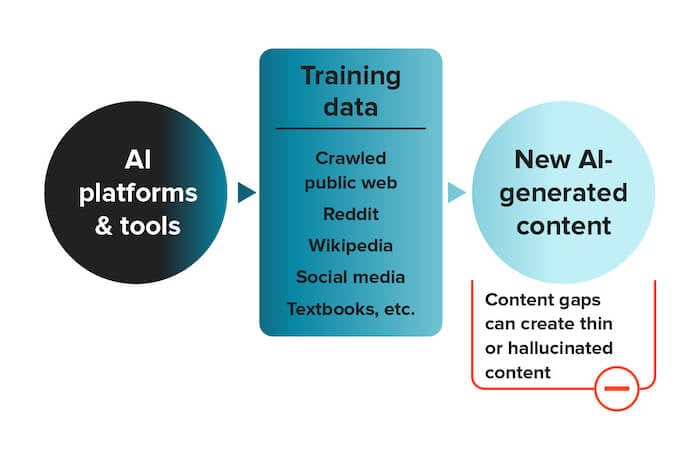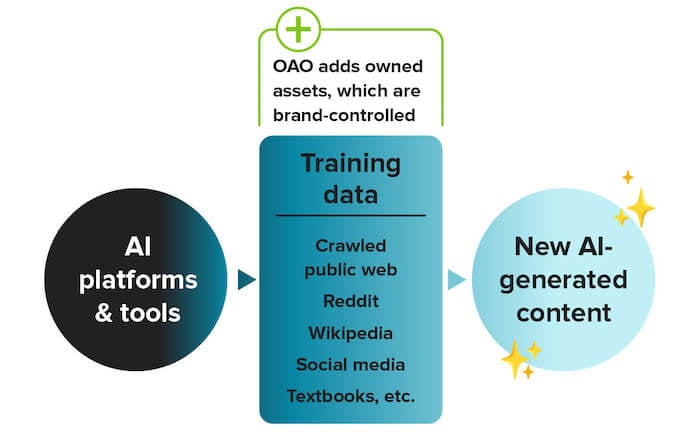Key Points
- The growth of generative AI and AI tools brings convenience to marketers, but it also threatens brand narrative control and consumer connections.
- Without brand guidance, AI can create uncontrolled content that can damage brand narrative and reputation.
- Owned asset optimization (OAO) creates brand-controlled content and a network of assets designed to influence the story AI tools tell about the brand.
The ascendance of artificial intelligence (AI) changes the game for marketers, creating hundreds of ways to analyze, make data-driven decisions, and generate written and visual content. The ability to make automated decisions and even use AI to optimize campaign collateral is unlocked when you build an AI marketing strategy.
At the same time, AI poses challenges and creates risk for brands and marketers. Overusing AI tools and cutting out human input results in marketing that doesn’t connect with humans. On the other hand, the growing use of AI by consumers — people asking ChatGPT or search engine AI questions — is taking control from brands and eroding narratives.
Owned asset optimization (OAO) dovetails with the rise of AI, lessening and mitigating some of these major concerns and challenges. OAO places the focus on the consumer, listening to the signals they create, and delivering what they are asking for. Doing this work to connect with consumers builds content that AI can leverage to accurately tell your brand story. OAO infrastructure handles both, limiting the potential harm of AI.
The risks of AI for brands and marketers
Here are some of the areas marketers should be concerned about:
AI-generated connection loss
The first risk is an internal one that impacts day-to-day marketing tasks. AI appears to provide a way to rapidly create content for marketing purposes. AI can be great for data analytics and marketing automation, but marketing teams that lead with AI-created content aren’t going to connect with consumers.
According to a 2023 study of ChatGPT’s content output versus human writing, AI content:
- Describes experiences instead of feelings.
- Avoids the use of personal pronouns.
- Uses unusual words.
- Avoids aggressive descriptions and vocabulary.
An article by MIT Technology Review suggests that AI is more likely to use common words like “the,” “it,” or “is” over more complex ones, almost never makes typos, and tends towards generating “perfect” text. Currently, ChatGPT’s ****** lack that certain something at the heart of human-crafted text. They lack the language range and emotional depth of human text, which puts limitations on connection.
Owned assets like blog posts require human input to connect with humans. As AI tools advance, the temptation to lean too much on the technology will worsen. Today’s brands thrive on real consumer connection and while AI can act as a digital assistant in pursuit of that goal, proceed with caution on this front. Focus on what your consumers want and need, and deliver solutions to their problems. AI can cut down on time investment, but AI is not a replacement for truly helping consumers.
Declining brand control
AI’s generative and search engine roles are wrenching narrative control from brands. When AI generates content or answers a query it becomes a rival storyteller. AI tools without internet access like ChatGPT require training and don’t have access to information beyond that. They use opaque datasets, combining things like web content, language data, and unspecified training data, pushing out new content and answers based on the datasets. Search engine AI uses crawled public web pages (live web content) in Google and Bing to answer queries.
The story brands want to tell is often not part of AI training data or isn’t available or optimized for AI search tools. Or maybe that story is limited and needs fleshing out. When AI users generate something, ask about a brand, or request other answers, AI only uses what it’s trained on or already has access to. Brands with suboptimal stories or less established narratives face the risk that AI will produce erroneous, unflattering, dated, or thin content. The more assets and content a brand creates, the more AI has to work with and the higher chance it gets added to future training of ChatGPT.
Eroding brand narrative
Generative AI can pose a significant narrative risk for brands because it produces uncontrolled content that can be published online. It creates uncontrolled content when people ask questions. And it creates uncontrolled content in the cutting edge tools like Google Search Generative Experience, which we’ll look at in a future piece.
Brands operating by default (i.e. not creating and optimizing owned assets) cede narrative control to AI. This loss of control can prevent authentic consumer connection, and ultimately, cause confusion, damage trust, and impact revenue and brand value.
Risks of “the AI disconnect”
AI isn’t an antagonistic force calculating to damage brand narrative. The risk is simply a result of something we’ll call “the AI disconnect.” It’s the data gap between what AI tools use to generate content or answer questions and the content that exists about brands online.
Without intervention by brands, AI’s process looks like this:

Because AI only uses what’s available to it (or what it’s trained with), it spits out content and answers that reflect this input. You can think of this as the hands-off version of AI’s process — one where brand marketers don’t take steps to influence the output.
This is how things typically go out in the wild, resulting in hallucinated, unflattering, dated, erroneous, or otherwise damaging content. This uncontrolled content can then fuel future uncontrolled AI content output as well.
We’ll touch on solving this below.
Owned asset optimization in the AI context
OAO offers a holistic approach to marketing that prioritizes consumer needs first and, in doing so, helps influence what AI produces and thereby solidifies brand narrative control.
The biggest benefits of OAO in the AI context include:
OAO’s human-centered content is AI-friendly
OAO’s focus is understanding consumers, identifying their pain points, and creating content, in the form of owned assets, to solve consumer problems. Solving problems equals trust, brand equity, and connection. The act of intentionally and strategically creating owned assets is a process of building human-centered content, to meet human needs. This ensures it connects with real people. When you create content to satisfy consumers, you are satisfying the demands of AI tools as well.
OAO increases narrative control
Owned assets are strategically developed to communicate the brand narrative across every consumer touchpoint, regardless of funnel stage. Each asset can tell part of that story to different audiences, directing “researching” consumers toward eventual buying decisions. This gives AI tools a way to understand the brand’s story. Without assets, influencing the output of AI tools is difficult and “the AI-disconnect” is likely to come into play. But when your brand is present and offering a consistent narrative across all of your assets, you fill the information gaps AI may have.
OAO builds brand-controlled content sources
Generative AI is data-hungry and requires massive datasets and amounts of content to carry out its highly sophisticated tasks. This applies to content about brands as well. Given OAO’s content-driven approach, developing assets that tell your story and connect with your audience, an OAO strategy asserts control and helps influence AI tools.
Brands with full asset networks create thousands of touchpoints and each one satisfies the demand of consumers and AI in its unique, small way. Together, this delivers the content depth and diversity AI tools and organic search requires for brands that want to stand out.
Brands that invest in creating owned assets supply their own data to AI, a move that bridges disconnect. Here’s how that looks:

Here, a brand builds a strong network of owned assets — content with a controlled narrative. Content that is diverse, accurate, defensive, authoritative, and iterative. This ensures that AI tools don’t just rely on what’s out there, but also pull in content from the owned assets the brand strategically created. This injects some control into the mix.
Note: Unlike Google Search Generative Experience and other AI search engines, tools like ChatGPT rely on infrequent training sessions instead of direct web access. While ChatGPT cannot grab live web content in real time, creating an owned asset network increases the probability of brand content getting pulled into the training dataset next time around.
OAO reflects the most current, accurate information
When building a constellation of owned, managed, and leveraged assets, brands develop these properties using the freshest, most accurate, and clear information possible. This work helps generative AI tools understand the truth about brands and clears up outdated information. Brands with outdated or uncontrolled content on the web can expect AI to reflect that stale information, generating similarly past-expiry content.
OAO creates authoritative content direct from the brand
Each owned asset presents an opportunity to host content that is unmediated — reaching the audience directly. Brands have always been the arbiters of their stories, but that’s diminished with consumer empowerment and the oversaturation of marketplace noise. OAO builds back story control with direct, brand-to-consumer touchpoints. This authoritativeness may signal content importance to AI and further influence content and answers it generates. Direct, brand-to-consumer connection, and the authority that undergirds it, works to soften AI-generated erosion of a brand’s message.
OAO builds a brand defense
Reputation management is a need that OAO addresses head-on, building a controlled, preferred narrative across a network of owned assets. AI and its continued evolution requires proactive work by brands and individuals building authoritative content to deploy an effective brand defense. Owned assets are numerous, diverse, filled with controlled content and strong narratives. They act as the defense against misinformation, negative news cycles, and the whims of AI, which can accelerate or perpetuate reputational harm.
OAO creates opportunities for brand evolution
OAO’s huge upside is that its asset network is adaptable and lends itself to quick changes dictated by brand and consumer needs. This freedom to refresh, realign, and re-strategize across assets at any time makes brand evolution more organic and feasible. Not only does OAO harvest Google search intent data that can reveal brand positioning opportunities, it also makes those changes in positioning instantly available to AI tools and consumers alike. If a brand makes changes across its web assets, AI search tools like Google Search Generative Experience (SGE) will have access to that context immediately.
OAO fosters authentic consumer connections
The fact is, some of the content we read online is created with AI tools like ChatGPT. Brands, media sites, blogs, and more are publishing AI content, or at least modified AI content, as original writing. This trend will likely grow as AI evolves, making it hard to tell the difference.
Owned assets are centered around building authentic connections by supporting real humans with content that answers their real questions. AI content can be cold, logical, and uninteresting. Compared to brands that use OAO, competitors leaning into AI too much for content creation will lose attention and market share.
OAO’s search intent data-derived consumer insights means it truly understands target audiences before creating owned assets and content. It guides content creation, resulting in content that actually helps consumers, delivers on customer needs, and connects on a deeper level. Sure, AI can create just about anything you ask for. But OAO content is built upon a foundation of understanding human needs. It uses this to make strong, authentic connections with consumers.
Navigating AI with OAO strategies
The best path forward into the AI future is to proactively tell your brand story through owned assets. Focus on creating content and investing in a network of assets that offer diversity, accuracy, authority, defense, and leaves room for growth. Do this with real people and human connection at heart, but understand that each asset also tells AI your brand story. OAO takes the data that AI uses for content creation and reclaims a layer of control for brands.
